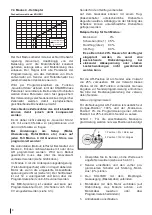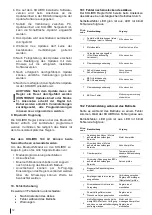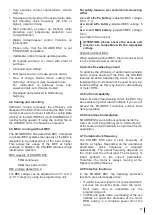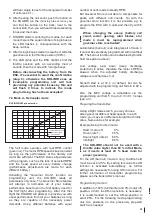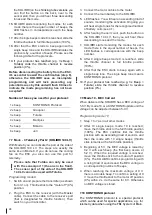
22
position 1 =
0 %
motor off
position 2 =
100 % full throttle
2
2
1
1
Check programming
afterwards!
1.
Before beginning, set all throttle trims and sub
trims to zero, set throttle travel adjust to 100 / 100,
and set your beginning throttle curve for
programming from 0-100% (see also from 3.1 on).
2.
Turn on the transmitter and move the throttle stick
to the 0% position.
3.
Plug the ESC to the receiver (with the Master
cable). Connect the cable to the receiver’s port
(that is designated for throttle function). Then
switch on your transmitter.
4.
Connect the motor cables to the motor (pay
attention to the motor’s direction of rotation – to
change direction, exchange two of the motor
cables or change via programming unit).
5.
Connect the main battery to the KOLIBRI.
6.
LED flashes. You will hear three ascending
tones, acknowledging the activation. Next, you
will hear single tones for the recognized number
of cells (see 4.1).
7.
After hearing the cell count, push the button on
the KOLIBRI (on the shrinking tube versions you
can find the button on the back, near to the
sensor slot), then you will hear three descending
tones and the mode.
8.
After 4 single beeps mode 4 is reached, move
the throttle stick to the full throttle position
(100%). The LED lights and the ESC confirm
first the throttle position with three ascending
tones, then the mode with 4 single beeps.
position 2 = 100%!
9.
Wait for a short time (max. 2 s), and disconnect
the main battery from the ESC.
Before disconnecting the battery from the
ESC, it's essential to await the confirmation
(step 8), otherwise the KOLIBRI sees an
incomplete programming and will lock
preventing any potential issues by this and
will flash 9 times to indicate the mode
programming has not been accepted!
Warning: after an interrupted autorotation,
resulting from the fast RPM spool-up, there
are extreme mechanical loads on the heli-
copter. Therefore, please tighten the main
rotor blades.
Using mode 4:
Prepare the transmitter for flight (see 3.5). Due to
the auto rotation quick start, the motor RPM returns
in a much shorter time to normal RPM after an
interrupted or unsuccessful autorotation (see
4.10). Therefore, abrupt autorotation bail outs are
possible.
The spool up time depends on the mass to be
accelerated and is set automatically to the current
conditions. So the fastest spool up time is always
available, without mechanical overloading.
The motor is switched off without delay, when
changing to the AR mode. When interrupting the
autorotation and switching on the motor, the
KOLIBRI ESC spools up the motor to the previously
adjusted RPM value as fast as possible. If the switch
remains for more than 90 seconds in the
autorotation position, the soft start will be activated,
when RPM is spooling up the next time.
7.5 Mode 6 - Forward / Backward
The Forward / Backward mode can drive the Motor
forward and reverse during operation (reverse,
default: off, reversible via programming unit).
The spool up behavior is default set to a mean
value. It can be modified in steps from "fast" to
"sluggish" via programming unit.
Mode 6 is characterized by complete throttle control
during the whole throttle travel without RPM control.
Under voltage slows down (deep discharge
protection)
the motor’s RPM when the adjusted
battery discharge voltage is reached (3.4). The
integrated
brake
(EMK-brake)
works
with
proportional increasing force (braking force is
depending on RPM).
The motor-off position is corresponding with the
neutral throttle position (middle of throttle travel).
The transmitter’s full-throttle-way prompts forwards,
the reverse position backwards. The KOLIBRI is
automatically detecting the throttle position.
!
Summary of Contents for KOLIBRI 140 LV
Page 14: ...14 ...

